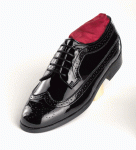Ernie has evaluated various tip configurations on Dragonwings; teardrop shape, droop tips and vane tips to turn the vortex the other way. Of all configurations, the squared off tip worked as well or better than any.
In actual measurements I made a number of years ago by plotting rotor disc angle of various rotors at constant airspeed, DWs had the lowest drag of the rotors available at the time; Skywheels, Rotordyne, Rotorhawk and Bensen. DWs had a lift/drag ratio of ~8:1 at 50 mph on a 500 lb. machine, second best were Skywheels at ~ 7:1.
Results were published in a Sunstate newsletter at the time. Someone must have a copy.
DWs on a Mini-500 provided a substantial performance increase over the stock blades. If the rotor rpm was allowed to drop into the yellow in a 3-ft. hover, the stock blades could not be powered out and a landing was inevitable. With DWs, simply roll on more power and fly away.
There is no scientific literature on square vs. rounded tips and it is reasonable to expect the aerodynamicists at Hughes knew what they were doing when they squared the tips on the Hughes OH-6/500.
There is considerable scientific literature on delaying the formation of shock waves on helicopter rotor tips, swept tips, ogee tips and arrowhead looking things. That’s not an issue with ordinary gyros.
Teardrop shaped tips do look nice on rotors but with respect to performance, it’s simply lipstick on a hog.
In actual measurements I made a number of years ago by plotting rotor disc angle of various rotors at constant airspeed, DWs had the lowest drag of the rotors available at the time; Skywheels, Rotordyne, Rotorhawk and Bensen. DWs had a lift/drag ratio of ~8:1 at 50 mph on a 500 lb. machine, second best were Skywheels at ~ 7:1.
Results were published in a Sunstate newsletter at the time. Someone must have a copy.
DWs on a Mini-500 provided a substantial performance increase over the stock blades. If the rotor rpm was allowed to drop into the yellow in a 3-ft. hover, the stock blades could not be powered out and a landing was inevitable. With DWs, simply roll on more power and fly away.
There is no scientific literature on square vs. rounded tips and it is reasonable to expect the aerodynamicists at Hughes knew what they were doing when they squared the tips on the Hughes OH-6/500.
There is considerable scientific literature on delaying the formation of shock waves on helicopter rotor tips, swept tips, ogee tips and arrowhead looking things. That’s not an issue with ordinary gyros.
Teardrop shaped tips do look nice on rotors but with respect to performance, it’s simply lipstick on a hog.

